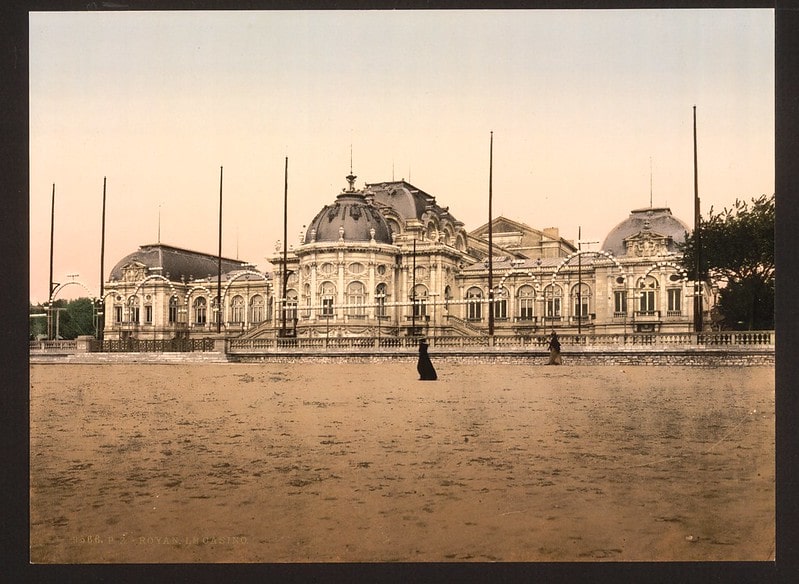Unsure about your French table manners? Click Here to download > > How to avoid these 10 food etiquette mistakes !
- Home ›
- Ze French ›
- Daily Life in France ›
- How to Choose a French Spa
Wellness in France: How to choose the perfect french spa stay
Updated 24 October 2025 by Leyla Alyanak — Parisian by birth, Lyonnaise by adoption, historian by passion
France’s spas aren’t just escapes for the self-indulgent — they’re part of the country’s medical and cultural DNA. Here's how to choose the best spas in France, along with the kind of experience you can expect.
Have you ever considered visiting a spa in France?
I ask because I’m just back from a few days in the French Alps at Brides-les-Bains, and it occurs to me that you might not know that France is one of the world’s premier wellness destinations, and home to some of the best spas in Europe.
QUICK PICKS: THE BEST SPAS IN FRANCE
If you just want inspiration before diving into the details, here are a few top choices beloved by both visitors and locals:
- Vichy – The “Queen of Spas,” UNESCO-listed and famous for its mineral-rich waters and Belle Époque charm.
- Evian-les-Bains (Haute-Savoie) – Lakeside resort using pure Evian spring water, ideal for detox and relaxation.
- Brides-les-Bains (Savoie) – Alpine spa town renowned for balneotherapy and weight-loss programs.
- Bagnoles-de-l’Orne (Normandy) – Pine-scented Belle Époque spa town with therapeutic thermal waters.
- Thalazur Saint-Jean-de-Luz (Basque Coast) – Seaside thalassotherapy center using Atlantic saltwater and seaweed.
- Trianon Spa, Versailles – Luxury spa next to the palace, perfect for an indulgent day trip from Paris.
Below you'll learn how French spas work, what makes them unique, and how to plan your own spa stay in France.
If you’ve been searching for the best spas in France or wondering how to choose the right one for you, this guide explains both, from thermal towns like Vichy and Evian to seaside thalasso centers and mountain retreats.
The different kinds of spa in France
Which type of French spa should you choose?
How to book your spa stay in France
What to pack for a spa in France
A few tips about going to French spas
NOTE: Pages on this site may contain affiliate links, which support this site. See full Privacy Policy here.
The different kinds of spa in France
France is a pioneer when it comes to thermal facilities, and I’ll talk more about history below.
There are several types of spa experiences available in France: thermal, thalassotherapy, balneotherapy, and wellness spas. Each is different depending on the type of water it uses, the style of treatment, and the setting.
There's an important distinction to remember: a cure thermale is a medical program, prescribed by a doctor, and takes place in an approved thermal establishment (and is usually reimbursed, at least in part) by French Social Security.
Hotel and day spas, on the other hand, are leisure and wellness experiences, and are outside the medical system. No prescription is needed, and you don't get reimbursed.
Hydrotherapy
This is the umbrella term that groups thermal establishments, thalassotherapy, balneotherapy and spas. In other words, coming from the Greek “thalassa” (meaning water or sea) covers all the different ways water is used to benefit your health.
Les Thermes
These are thermal establishments, and mostly dedicated to medical therapies. Descendants of the Roman baths, they tend to be located along mountain and volcano foothills, in areas with natural springs. As you know, France is heaven for springwaters like Vichy or Evian (and many more).
Each spring has different qualities so each establishment treats different illnesses. These thermal “cures”, as they are called, last around three weeks and are prescribed by doctors − and paid for by France’s generous social security system. At least the treatments are paid for, because individuals still have to pay for accommodation and (usually) meals.
There are also “cures libres”, also sometimes called “mini-cures”, which can last up to 12 days but are not subsidized by the government. If you’d rather have medical input into your spa stay, this might be for you.
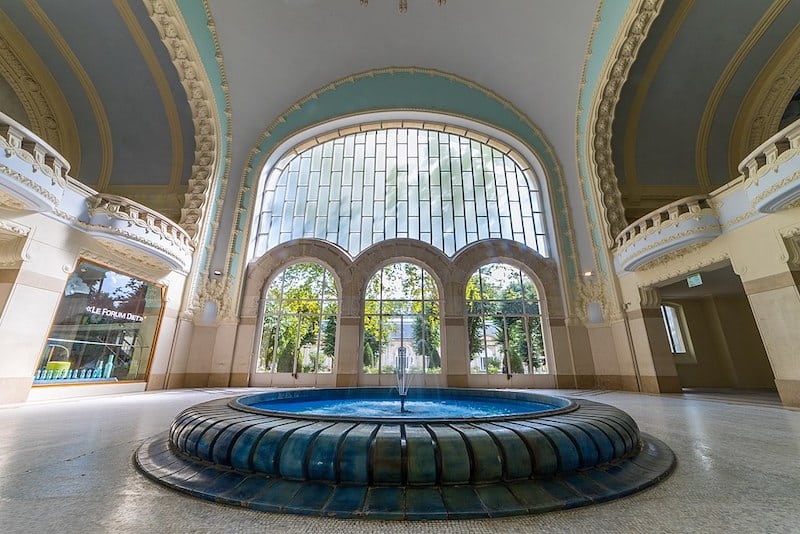 Entrance to the Thermes les Dômes in Vichy, one of the most popular French resort towns. Like most thermal establishments, spaces are huge and often grandiose. Photo Oeildemickael, CC BY-SA 4.0, via Wikimedia Commons
Entrance to the Thermes les Dômes in Vichy, one of the most popular French resort towns. Like most thermal establishments, spaces are huge and often grandiose. Photo Oeildemickael, CC BY-SA 4.0, via Wikimedia CommonsTIP: If you’re curious about the medical side of French spas, look for towns officially labeled “station thermale”, which means they are recognized as thermal destinations by the government.
Thalassotherapy
Also called “thalasso” for short, these are spas thas use products linked to the sea such as saltwater, seaweed, mud and the like.
They are naturally located by the sea, both along the Mediterranean and along the Atlantic. The sea water is heated and filtered and these spas often specialize in weight loss and energy boosting.
Popular thalasso centers include Saint-Malo, Carnac, Saint-Jean-de-Luz, Antibes, and plenty more, with spas working to combine the sea water and sea air for our health. As I write this I'm headed to Ouistreham in Normandy for precisely this combination.
Balneotherapy
This is different from thalassotherapy in that it doesn’t use saltwater but uses regular or mineral water. Usually, these spas are located in the mountains and are often twinned with thermal establishments, with medical cures on one side of the building and balneotherapy on the other.
The one I just visited in Brides-les-Bains was a balneotherapy spa, with a thermal cure establishment in the same building.
These are ideal if you prefer mountain scenery and fresh air to the milder coast. It's also ideal if you want to combine your spa programs with hiking or fitness sessions.
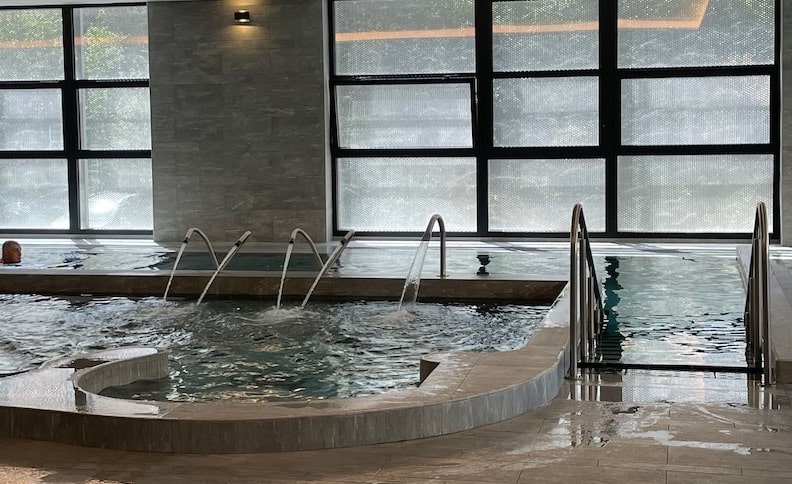 A corner of the pool at Brides-les-Bains (the phone almost slipped out of my hands!)
A corner of the pool at Brides-les-Bains (the phone almost slipped out of my hands!)A spa
A properly named spa tends to go beyond water treatments and offers “dry treatments”, such as massages or facials. You can book a stay in a spa, also known as a resort spa, for a weekend, several days or a week.
Many hotel-based spas in France fall into this category, from luxury chains to boutique retreats. They’re perfect for short getaways of up to a week.
Day spa
As its name implies, this is where you can go for the day or for a few hours. They have a wide range of treatments and are often attached to hotels so that you can take advantage of them during your stay, like these Paris spa hotels.
If you’re short on time, you’ll find excellent day spas in major cities such as Paris, Lyon, Marseille, and Bordeaux. Many allow online booking and offer services in English for an international clientele.
Which type of French spa should you choose?
Spa, balneotherapy, thalassotherapy… how confusing does it get?
Basically your choice boils down to this: saltwater or unsalted water.
Each has advantages.
The benefits of using salt water are well known: being by the sea and breathing in the salt air is healthy for a number of conditions, along with helping you detox and rebuild your immunity. Its benefits are documented here.
As for balneotherapy, the combination of water, heat and pressure from jets helps relieve joint and muscle pain, while floating in tubs and pools makes you feel lighter and puts less stress on the various parts of your body. For more about balneotherapy, see here.
Some of these establishments may have an in-house doctor, but they are designed for wellness, not medical care. If it’s a doctor’s eye that you want, then try a “cure libre” in one of France’s 109 thermal establishments (site in French).
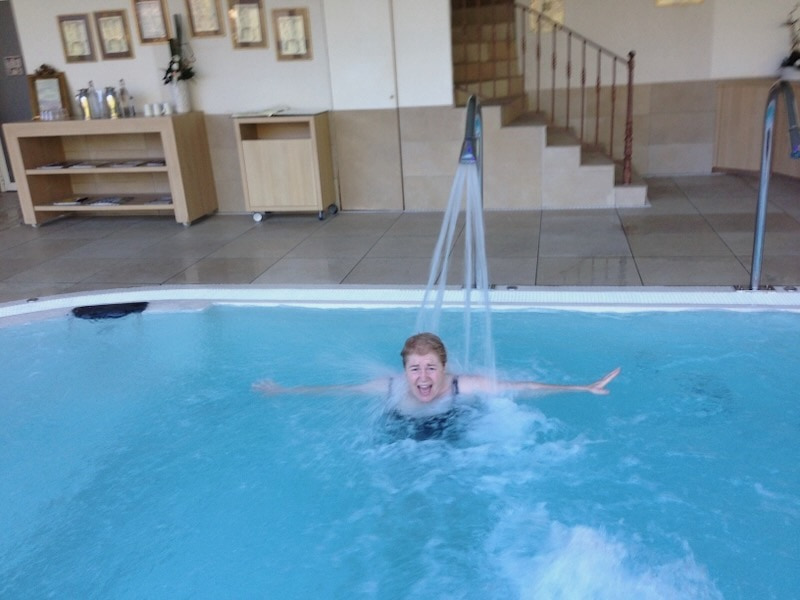 That's me, enjoying the waters at a spa in the Beaujolais - the water was surprisingly strong!
That's me, enjoying the waters at a spa in the Beaujolais - the water was surprisingly strong!Frankly, though, I just choose depending on whether I’d rather be by the sea or in the mountains at any given time. The end result tends to be the same (and I’ve tried both types ample times): you leave filled with energy, lighter, more relaxed and balanced, and better in your body.
In short: choose thalasso if you love the sea, balneo if you prefer the mountains, and thermal if you're after real medical benefits.
How long shall I go for?
You can normally find spa treatments that last 3, 6 or 7 days. Three days is fine if all you want is to relax and enjoy yourself. (The medical cures last 18 days, but that's not what we're looking at here.)
But if you actually want to reap some of the health benefits of salt or mineral waters, then six days is an absolute minimum. Some establishments offer three treatments a day, others four. I never settle for fewer than four.
Some spas are now offering 9-day stays and I have to say, I’m very tempted to try.
Expect to be tired after the first few days, but don’t worry, you’ll perk up near the end!
TIP: Many spas offer discounts on certain days of the week or during certain periods of the year. Avoid the school holidays if you'd rather have less noise and pay less too.
What is a typical day in a French spa like?
Spas are by no means identical but they tend to function in similar ways, whether you’re in the mountains or by the sea, along the French Riviera or in the Alps.
If you’re wondering what a “day at the spa” in France actually looks like, here’s how most programs work.
As soon as you arrive in town, head for the spa to register and pay any pending fees. You’ll be handed your schedule. In some spas, you’ll be asked to see the resident doctor, a visit you’ll have to pay for. It depends on the spa, and I suspect the doctor’s visit is more about liability than health. Any examination I’ve ever had was extremely cursory.
To give you an idea of what to expect, here’s what my three-day schedule looked like at Brides-les-Bains:
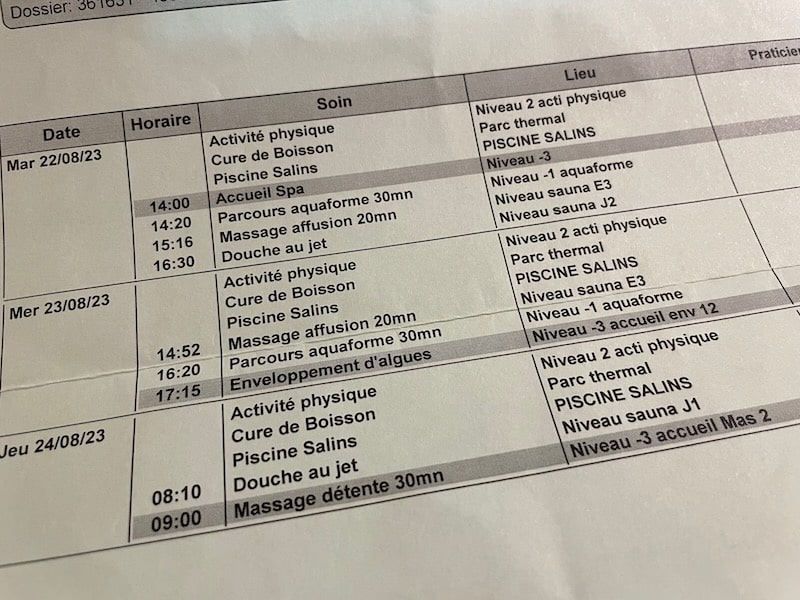
In case you don’t read French, here’s my translation:
- Day 1: aquagym in the pool, massage under gentle water drizzle, water jet
- Day 2: massage under gentle water drizzle, aquagym, seaweed wrap
- Day 3: water jet, relaxing massage
Most spas offer treatments that alternate between mornings and afternoons. Each day, you’ll also have full access to the sauna, steam baths, whirlpools, or gym classes.
Your “scheduled” spa treatments may be divided into categories such as these:
- Pool work, which can include exercises, a counter-current pool, water polo or other games
- Showers, from a strong jet shower to slow drips
- Massages, whether with oils or under water or with hot stones
- Wraps in seaweed or mud
- Exercise classes, group meditation, cooking and nutrition conferences or workshops
Remember though, each spa is different so allow for flexibility!
Once you’ve arrived, registered, and received your schedule, you’ll be shown the changing rooms and the various facilities. Expect to get lost on the first day! For some reason, spas in France seem to be built by the same engineers who build France’s parking lots – they like mazes…
You’ll usually receive a bathrobe and towel, and possibly some non-slip sandals. If these aren’t provided, you’ll be expected bring your own, and often a bathing cap. Every spa I’ve ever been to provides you with a bag in which to tote your belongings.
Your treatments will each take place in different areas of the spa. Usually, there will be a desk and a waiting room in each section. Give your name, and wait to be called.
You’ll probably wear your bathing suit for most treatments but at times, you may be asked to lower it, for example for massages, or to take it off completely, such as for mudbaths. Some spas have nude sections, or may be entirely nude in saunas and steam baths, although this is becoming increasingly rare.
How to book your spa stay in France
And now, to book.
Most spas belong to one of the spa networks, and these networks usually have “thalasso” in their name. That does NOT mean that you can only book thalassotherapy through them. You can also book balneotherapy (unsalted water).
When you browse these networks, you’ll see they offer both seaside and mountain stays. Those by the sea will use seawater, whereas those in the mountains won’t. Where available, like in Vichy, they will use mineral water. Otherwise, it’ll be plain water. You’ll have to read through each individual offering to find out.
Many deals include hotels with the spa package. If you find the hotels too expensive, you can still usually reserve the spa treatments and stay someplace else. Most spa towns have plenty of private accommodation, or you can Google [studio + location]. I often stay in a studio if I’m gone for a full week so that I can cook for myself.
For my recent stay at Brides-les-Bains, I booked the spa on its own, and then looked around for a suitable hotel – I found one right next door. During another spa stay, I booked hotel and spa jointly. And in yet another, I booked the spa but also found a studio for a week.
It depends on you, and on the availability, location and price.
TIP: Before booking, check whether the establishment offers packages labeled “forfaits bien-être” (well-being packages) or “séjour découverte.” These are short spa stays, often three to five days, ideal for visitors to France who want a French spa experience without committing to a full cure.
To do your research, most sites below will unfortunately be in French and you’ll have to use Google Translate or a friend to do your research. However, once at the spa, there’s always someone who speaks some English to give you the grand tour or explain how things work. I’ve often seen non-French speakers during my spa stays and someone was always available to explain things in English.
Here are some of the networks through which you can book your spa stays: some work with certain spas exclusively, others are aggregators. You’ll have to arm yourself with a bit of patience.
(Please read the fine print because some of these listings may also include medical cures.)
Frankly, I’ve never been to a BAD spa in France. Some have better pools, others have more skilled massage practitioners, and yet others have a wider variety of options.
Bottom line: throw open your windows first thing in the morning, and gaze at the sea or mountains. Take a deep breath, and prepare to take care of yourself for the day.
Best spas in France
There are plenty of listings dealing with the best French spas, and each one contains different spas. What gives?
Spas are personal, that’s what. Yes, certain facilities may be more luxurious, more modern, or the bathrobes softer, but what I look for in a spa isn’t necessarily what you look for. For example, my recent spa resort was proud of its several steam bath or hammam offerings, yet I don’t use steam baths so this didn’t move me. A magnificent pool with plenty of roiling water will.
With that in mind, I’ve gathered some suggestions that combine my personal choices with those of several others to bring you this short list of suggestions.
You can also use this list as a starting point if you’re researching “spas in France” for an upcoming trip. Each one is easily reachable by train or car.
Best French Alps spa: I’ll vote for Brides-les-Bains, where I’ve just come from. The facilities are excellent, there are plenty of them, and the practitioners I met with were all topnotch. For a chalet experience, try Le Coucou in nearby Méribel. Down the Alps on the shores of Lake Geneva, I’d recommend the Evian Thermes (site in French), for their use of Evian water.
Best vineyard spa: Chateau de Pizay in the heart of the Beaujolais. It’s a small spa, but the early-morning vineyard walks are just as healthy as a massage! The gastronomic restaurant doesn’t hurt, either.
Best spa south of France: Thalazur Antibes, Thalazur Saint-Jean-de-Luz, and Thalacap Camargue (this last one is more for the location).
Best thermal spa in France: Impossible to choose, because each has a specialty. For example, Avène-les-Bains is one of the top thermal spas in France, but it deals strictly with dermatology.
Best luxury spa in France: Trianon-Versailles, right next to Versailles Palace. Greco-Roman design fit for a queen (and king, of course).
Best French spa town: Vichy, one of 11 Great Spa Towns of Europe on UNESCO’s World Heritage List. Known as the “Queen of Spas” it was instrumental in the expansion of the 19th-century spa movement in France. Or go the opposite: La Grande Motte. Many people come to France for its picturesque villages – this is the absolute opposite: modernist, concrete, emerged from a swamp where nothing existed.
Best day spa in Paris: The Dior Spa at Cheval Blanc, of course, and the Spa at the Mandarin Oriental. Also the Nuxe Spa, and for something more “world”, the Spa Cinq Mondes.
WHAT IS THE FRENCH FOR SPA?
Ermmm... SPA. Le spa. Yes, the same word! And pronounced the same way.
BUT – if you pronounce each letter individually, as in ess-pay-ah, you'll be talking about the Animal Protection Society.
What to pack for a spa in France
Of course you’ll pack the same things you’d usually pack for a short holiday, but make sure you add these as well:
- Your bathing suit, of course. A one-piece is most comfortable, but if you wear a bikini, make sure it’s not flimsy enough to fly off each time the strength of the shower hits.
- Bathing cap and non-slip sandals (you can usually buy these at the spa if you don’t have them).
- Your own hair products because all this water can be rough on your hair, and hotel and spa showers usually don’t have specialized hair products.
- A book to read. You can’t really cart your phone or kindle around with you because you’ll be in and out of the water the entire time.
- Gym shoes if you plan on using the gym.
- Men should make sure they have speedo-type swimsuits – the loose bermuda or short-type swimming trunks often worn in North America aren’t accepted here.
A few tips about going to French spas
- If you need to buy anything, like a bathing suit or sandals, check if there’s an Intersport or Decathlon shop nearby. Prices in spas can be sky-high and you’ll get the same quality at half the price in a sports shop.
- Saunas and steam baths are often mixed, so you’ll wear your bathing suit. But ask because some spas have special times for men and women.
- Think about your meals. Some hotels offer half-board, or “demi-pension”, usually breakfast and dinner. But if you go out and eat, you may be tempted to indulge and undo all the good your “cure” has done you!
- If you’re in a place with plenty of tourist attractions, don’t plan too much during your free half-day − chances are you’ll be exhausted, at least during the first few days.
A bit of French spa history
We’ve now dealt with all the practicalities of going to a French spa, but we need to understand a bit of history for a sense of just how solidly water treatments are entrenched in France.
Spas have been around since Antiquity of course, when the Romans used mineral waters to cure certain ills, especially those related to skin, muscles and joints. Whenever your travel around Roman France, you’re sure to find some remnants of long-ago baths built by the Romans.
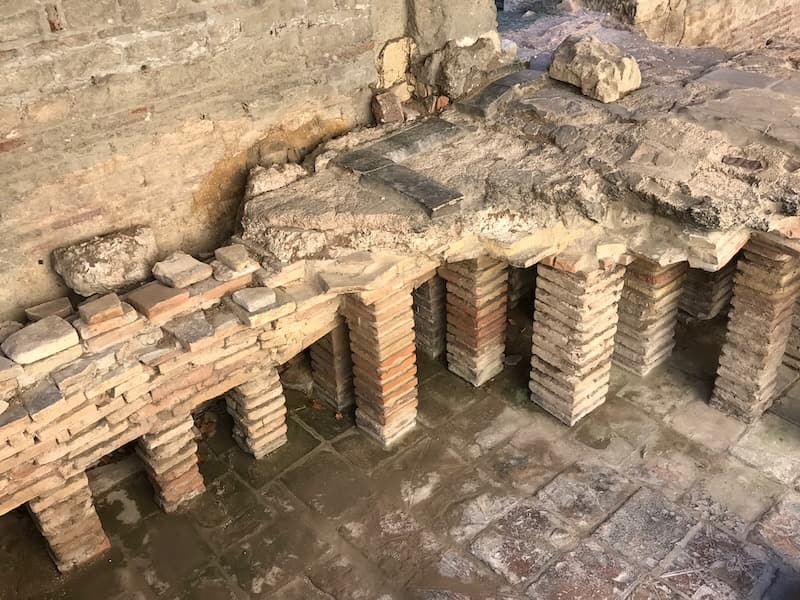 Baths of Constantine in Arles - at least what's left of them
Baths of Constantine in Arles - at least what's left of themIn fact, some of today’s establishments are built right on top of their old Roman precursors.
But with the fall of the Roman Empire, baths fell into disuse, their rebirth having to wait until the Middle Ages, with the rediscovery of the therapeutic benefits of baths and mineral waters.
Thermalism (yet another word for water treatments) grew during the Renaissance and the first Charter of Mineral Waters was issued by Henri IV as far back as 1604. Even four centuries ago, France’s rulers understood the benefits of “taking the waters”.
Building of thermal establishments picked up during the 18th century, especially after Napoleon Bonaparte decreed that only thermal towns would be allowed to have a casino − so you can image how quickly those towns became popular!
By the time of Napoleon III (Napoleon I’s nephew) and the Belle Epoque of the 19th century, people were flocking to the baths and thermal towns had become luxurious, attracting high society and crowned heads, like Queen Victoria in Aix-les-Bains. The building of France’s great railways also made it easier for Parisians (and foreigners) to reach the best spa towns.
All this elitism disappeared during the 20th century with the arrival of mass tourism and social security, making baths more democratic and accessible to the less wealthy. They would also evolve with the times and create new offerings, including shorter weekend stays.
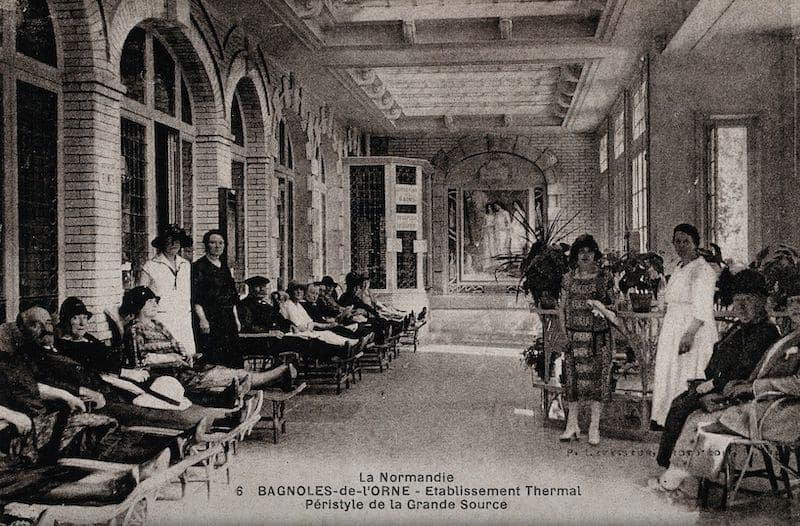 reclining at the Bagnoles de l'Orne thermal establishment during the Belle Epoque. Photographic postcard, ca. 1920. Wellcome Collection via CC BY 4.0
reclining at the Bagnoles de l'Orne thermal establishment during the Belle Epoque. Photographic postcard, ca. 1920. Wellcome Collection via CC BY 4.0Today, France ranks near the top of the class when it comes to wellness establishments, with many mineral springs and more than 100 thermal establishments.
France’s 11 UNESCO-listed “Great Spa Towns of Europe” include Vichy, Évian-les-Bains and Aix-les-Bains, an official recognition of France’s centuries-old spa culture.
Spa accommodation in France
If you decide to stay in a hotel or holiday let and book your spa separately, this map will help you find accommodation anywhere in France.
A world of spas
France is clearly a world leader when it comes to wellness stays and from luxury spa to budget, you’ll always find something suitable, whatever ails you.
France’s centuries-old know-how has been put to good use. And even if you don’t speak a word of French, you’ll be able to enjoy a spa in France. The hardest part is the research and booking: after that, the entire process is quite simple. Just keep your schedule with you, and show it to a member of staff if you’re not sure what happens next.
It’s a wonderful experience and I encourage you to try it if you have the time (and the inclination, of course!)
FAQ
Are French spas only for women or do men go too?
Are French spas only for women or do men go too?
About 70% are women, but an increasing number of men are booking stays.
What do you wear to a spa in France?
What do you wear to a spa in France?
You should arrive in your normal street clothes and once inside, you’ll be given a bathrobe and slippers. The few spas that might not provide these (ask first) will ask you to bring your own, but I haven’t encountered this situation yet.
How much does a spa day in France cost?
How much does a spa day in France cost?
It varies, but should fall within the €60-200 range.
Do you need to book spa treatments in advance?
Do you need to book spa treatments in advance?
Most of the time, you do. Some larger spas have walk-in policies, but you'll only be able to use the pools, sauna and hammam. If you want a treatment, such as a massage, you'll have to book ahead of time.
Are children or teens allowed in French spas?
Are children or teens allowed in French spas?
Most French spas welcome guests aged 16 and over, though some family-friendly thalassotherapy centers allow younger teens during specific hours. Children generally aren’t admitted to saunas or thermal pools, though there are exceptions, and minors need parental consent for any treatments.
Before you go...
If you’re intrigued by the French devotion to detail, from spa treatments to savoir-faire, have a look at Made in France: Creations, Crafts and Creativity for a glimpse into the artisans who keep France’s heritage alive.
Did you enjoy this article? I'd love if you shared it!
